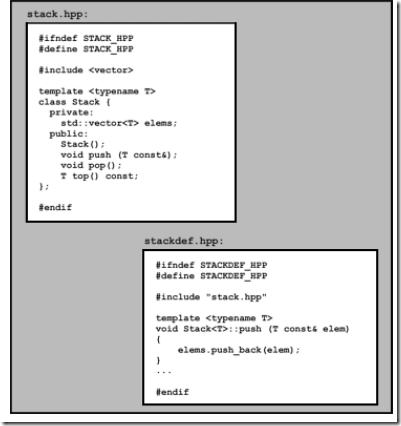c++ template(5)模板实战
2013-03-13 14:04 Clingingboy 阅读(444) 评论(0) 编辑 收藏 举报
一.包含模型
一份头文件hpp,一份cpp实现文件
hpp:
#ifndef MYFIRST_HPP
#define MYFIRST_HPP
// declaration of template
template <typename T>
void print_typeof (T const&);
#endif // MYFIRST_HPP
cpp:
#include <iostream>
#include <typeinfo>
#include "myfirst.hpp"
// implementation/definition of template
template <typename T>
void print_typeof (T const& x)
{
std::cout << typeid(x).name() << std::endl;
}
使用模板函数:
#include "myfirst.hpp"
// use of the template
int main()
{
double ice = 3.0;
print_typeof(ice); // call function template for type double
}
将会导致链接错误,必须有一个基于double实例化的函数定义
为了通过编译,有2两种办法:
1.把cpp文件包含在头文件里面
2.在使用模板的文件中引用cpp文件
3.不要cpp文件,将声明和实现都放在hpp文件里面
#define MYFIRST_HPP
#include <iostream>
#include <typeinfo>
// declaration of template
template <typename T>
void print_typeof (T const&);
// implementation/definition of template
template <typename T>
void print_typeof (T const& x)
{
std::cout << typeid(x).name() << std::endl;
}
#endif // MYFIRST_HPP
开销:
1.增加了头文件的大小
2.增加了编译复杂度
二.手工显式实例化
声明一个显式实例化的头文件
#include "myfirst.hpp"
// explicitly instantiate print_typeof() for type double
template void print_typeof<double>(double const&);
现在使用这个头文件,编译正常
#include "myfirstinst.cpp"
// use of the template
int main()
{
double ice = 3.0;
print_typeof(ice); // call function template for type double
}
优点:避免了庞大的头文件开销
注意点:一个程序中最多只有一个显式实例化体
三.整合包含模型和显式实例化
如上声明3份文件.
- 1份头文件
- 1份实现文件
- 一份显式实例化文件
如下2种用法:
第一种使用应该引用“stackdef.hpp”






【推荐】国内首个AI IDE,深度理解中文开发场景,立即下载体验Trae
【推荐】编程新体验,更懂你的AI,立即体验豆包MarsCode编程助手
【推荐】抖音旗下AI助手豆包,你的智能百科全书,全免费不限次数
【推荐】轻量又高性能的 SSH 工具 IShell:AI 加持,快人一步
· AI与.NET技术实操系列:基于图像分类模型对图像进行分类
· go语言实现终端里的倒计时
· 如何编写易于单元测试的代码
· 10年+ .NET Coder 心语,封装的思维:从隐藏、稳定开始理解其本质意义
· .NET Core 中如何实现缓存的预热?
· 分享一个免费、快速、无限量使用的满血 DeepSeek R1 模型,支持深度思考和联网搜索!
· 25岁的心里话
· 基于 Docker 搭建 FRP 内网穿透开源项目(很简单哒)
· ollama系列01:轻松3步本地部署deepseek,普通电脑可用
· 按钮权限的设计及实现